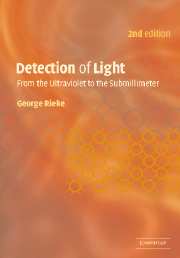Book contents
- Frontmatter
- Contents
- Preface
- 1 Introduction
- 2 Intrinsic photoconductors
- 3 Extrinsic photoconductors
- 4 Photodiodes and other junction-based detectors
- 5 Amplifiers and readouts
- 6 Arrays
- 7 Photoemissive detectors
- 8 Photography
- 9 Bolometers and other thermal detectors
- 10 Visible and infrared coherent receivers
- 11 Submillimeter- and millimeter-wave heterodyne receivers
- 12 Summary
- Appendices
- References
- Index
5 - Amplifiers and readouts
Published online by Cambridge University Press: 09 November 2009
- Frontmatter
- Contents
- Preface
- 1 Introduction
- 2 Intrinsic photoconductors
- 3 Extrinsic photoconductors
- 4 Photodiodes and other junction-based detectors
- 5 Amplifiers and readouts
- 6 Arrays
- 7 Photoemissive detectors
- 8 Photography
- 9 Bolometers and other thermal detectors
- 10 Visible and infrared coherent receivers
- 11 Submillimeter- and millimeter-wave heterodyne receivers
- 12 Summary
- Appendices
- References
- Index
Summary
To be useful, the output signal from any of the detectors we have discussed must be processed by external electronics. Conventional electronics, however, are not very well suited for an infinitesimal current emerging from a device with virtually infinite impedance. Nonetheless, highly optimized circuit elements have been developed to receive this type of signal and amplify it. Most of these devices are based on very high input impedance, low-noise amplifiers that can be built with field effect transistors (FETs). FETs are used in a variety of circuits that are constructed to give the desired frequency response and to accommodate the electrical properties and operating temperature of the detector, among other considerations. In the most sensitive circuits, signals of only a few electrons can be sensed reliably.
Building blocks
There are two basic kinds of transistor out of which amplifiers for the detector outputs could be built: bipolar junction transistors (BJTs) and field effect transistors (FETs). BJTs are generally unsuitable for directly receiving the signal from the detectors we have been discussing because they have relatively modest input impedances. FETs are used to build first-stage electronics for virtually all high-sensitivity detectors.
There are two basic classes of FET: the junction field-effect transistor (JFET) and the metal—oxide—semiconductor field-effect transistor (MOSFET).
- Type
- Chapter
- Information
- Detection of LightFrom the Ultraviolet to the Submillimeter, pp. 116 - 144Publisher: Cambridge University PressPrint publication year: 2002



